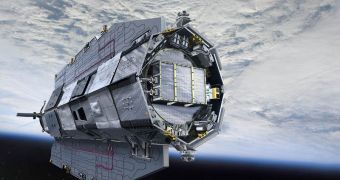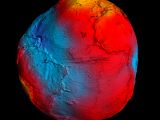Officials with the European Space Agency (ESA) announce that the Gravity Field and Steady-State Ocean Circulation Explorer (GOCE) satellite reentered Earth's atmosphere at around 00:00 GMT today, November 11. The spacecraft was nearly entirely burned up high above the Pacific Ocean.
GOCE's orbital path took it above Siberia, the western part of the Pacific Ocean, the eastern Indian Ocean, and then Antarctica. About 75 percent of the satellite was completely destroyed upon atmospheric reentry, but nearly a quarter of the spacecraft made its way to Earth's surface.
The satellite, widely held as the most beautiful ever designed and launched, has been falling towards the ground for the better part of three weeks, after exhausting its fuel supply on October 21. It was powered by an innovative ion engine that kept it flying in an extremely-low orbit.
GOCE occupied a geocentric, Sun-synchronous orbit much lower than that of the International Space Station, featuring a perigee of 195 kilometers (121 miles) and an apogee of 201 kilometers (125 miles). In effect, the satellite was continuously free-falling.
In order to maintain a stable orbit, the spacecraft was outfitted with its iconic fins, and was shaped like an arrow. Additional lift was generated by an ion engine, which provided smooth thrust that did not interfere with the satellite's extremely-sensitive measurements of Earth's gravity field.
Though originally scheduled to remain in operation for 20 months, GOCE spent 55 months collecting scientific data. It was launched aboard a Rokot rocket featuring a Briz-KM upper stage from the Plesetsk Cosmodrome, in Russia, on March 17, 2009.
During its time in space, GOCE create the most accurate representation of the geoid to date. The geoid is a hypothetical dataset that shows what a global ocean would look like on an Earth without landmasses.
ESA experts estimate that roughly 275 kilograms (about 600 pounds) of the satellite's total mass reached Earth's surface following its destruction. However, this is not likely to cause any problems.
“The one-tonne GOCE satellite is only a small fraction of the 100–150 tonnes of man-made space objects that reenter Earth’s atmosphere annually. In the 56 years of spaceflight, some 15,000 tonnes of man-made space objects have reentered the atmosphere without causing a single human injury to date,” says the leader of the Space Debris Office at ESA, Heiner Klinkrad.

 14 DAY TRIAL //
14 DAY TRIAL // 
